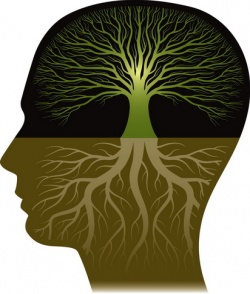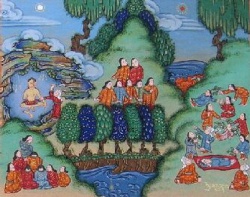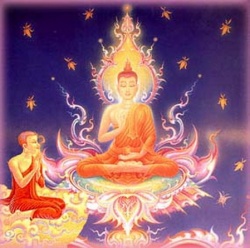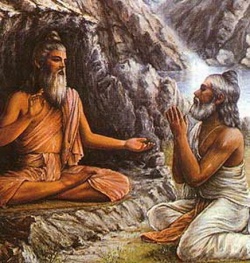Paccaya
paccaya: 'condition', is something on which something else, the so-called 'conditioned thing', is dependent, and without which the latter cannot be. Manifold are the ways in which one thing, or one occurrence, may be the condition for some other thing, or occurrence. In the Patthāna, the last book of the Abhidhamma Pitaka (comprising 6 large vols. in the Siamese edition), these 24 modes of conditionality are enumerated and explained, and then applied to all conceivable mental and physical phenomena and occurrences, and thus their conditioned nature is demonstrated.
The first two volumes of the Patthāna have been translated into English by the Venerable U Nārada (Mūlapatthāna Sayadaw) of Burma, under the title Conditional Relations (Published by the Pāli Text Society, London 1969, 1981). For a synopsis of this work, see Guide VII.
The 24 modes of conditionality are:
1. Root condition: hetu paccaya
2. Object: ārammana
3. Predominance: adhipati
4. Priority: anantara
5. Contiguity: samanantara
6. Co-nascence: sahajāta
7. Mutuality: aññamañña
8. Support: nissaya
9. Decisive Support: upanissaya
10. Pre-nascene: purejāta
11. Post-nascene: pacchājāta
12. Repitition: āsevana
13. Karma: kamma
14. Karma-result: vipāka
15. Nutriment: āhāra
16. Faculty: indriya
17. Jhāna: jhāna
18. Path: magga
19. Associaton: sampayutta
20. Dissociation: vippayutta
21. Presence: atthi
22. Absence: natthi
23. Disappearance: vigata
24. Non-disappearance: avigata
(1) Root-condition (hetu-paccaya) is that condition that resembles the root of a tree. Just as a tree rests on its root, and remains alive only as long as its root is not destroyed, similarly all karmically wholesome and unwholesome mental states are entirely dependent on the simultaneity and presence of their respective roots, i.e., of greed (lobha), hate (dosa), delusion (moha), or greedlessness (alobha), hatelessness (adosa), undeludedness (amoha). For the definition of these 6 roots, s. mūla.
"The roots are a condition by way of root for the (mental) phenomena associated with a root, and for the corporeal phenomena produced thereby (e.g. for bodily expression)" (Patth).
(2) Object-condition (ārammana-paccaya) is called something which, as object, forms the condition for consciousness and mental phenomena. Thus, the physical object of sight consisting in colour and light ('light-wave'), is the necessary condition and the sine qua non for the arising of eye-consciousness (cakkhu-viññāna), etc.; sound ('sound wave') for ear-consciousness (sotā-viññāna), etc.; further, any object arising in the mind is the condition for mind-consciousness (mano-viññāna). The mind-object may be anything whatever, corporeal or mental, past, present or future, real or imaginary.
(3) Predominance-condition (adhipati-paccaya) is the term for 4 things, on the preponderance and predominance of which are dependent the mental phenomena associated with them, namely: concentrated intention (chanda), energy (viriya), consciousness (citta) and investigation (vīmamsā). In one and the same state of consciousness, however, only one of these 4 phenomena can be predominant at a time. "Whenever such phenomena as consciousness and mental concomitants are arising by giving preponderance to one of these 4 things, then this phenomenon is for the other phenomena a condition by way of predominance" (Patth.). Cf. iddhi-pāda.
(4-5) Proximity and contiguity (or immediacy)-condition (anantara and samanantara-paccaya) - both being identical - refer to any state of consciousness and mental phenomena associated with them, which are the conditions for the immediately following stage in the process of consciousness. For example, in the visual process, eye-consciousness is for the immediately following mind element - performing the function of receiving the visible object - a condition by way of contiguity; and so is this mind-element for the next following mind-consciousness element, performing the function of investigating the object, etc. Cf. viññāna-kicca.
(6) Co-nascence condition (sahajāta-paccaya), i.e. condition by way of simultaneous arising, is a phenomenon that for another one forms, a condition in such a way that, simultaneously with its arising, also the other thing must arise. Thus, for instance, in one and the same moment each of the 4 mental groups (feeling, perception, mental formations and consciousness) is for the 3 other groups a condition by way of co-nascence or co-arising; or again each of the 4 physical elements (solid, liquid, heat, motion) is such a condition for the other 3 elements. Only at the moment of conception in the mother's womb does corporeality (physical base of mind) serve for the 4 mental groups as a condition by way of co nascence.
(7) Condition by way of mutuality (aññāmañña-paccaya). All the just mentioned associated and co-nascent mental phenomena, as well as the 4 physical elements, are, of course, at the same time also conditioned by way of mutuality, "just like three sticks propped up one by another." The 4 mental groups are one for another a condition by way of mutuality. So also are the 4 elements, and also mentality and corporeality at the moment of conception.
(8) Support-condition (nissaya-paccaya). This condition refers either to a pre-nascent (s. 10) or co-nascent (s. 6) phenomenon which is aiding other phenomena in the manner of a foundation or base, just as the trees have the earth as their foundation, or as the oil-painting rests on the canvas. In this way, the 5 sense-organs and the physical base of the mind are for the corresponding 6 kinds of consciousness a prenascent, i.e. previously arisen, condition by way of support. Further all co-nascent (s. 6) phenomena are mutually (s. 7) conditioned by each other by way of support.
(9) Decisive-support (or inducement) condition (upanissaya-paccaya) is threefold, namely:
(a) by way of object (ārammanūpanissaya-paccaya),
(b) by way of proximity (anantarūpanissaya),
(c) natural decisive support (pakatupanissaya).
These conditions act as strong inducement or cogent reason.
(a) Anything past, present or future, corporeal or mental, real or imaginary, may, as object of our thinking, become a decisive support, or strong inducement, to moral, immoral or karmically neutral states of mind. Evil things, by wrong thinking about them, become an inducement to immoral life; by right thinking, an inducement to moral life. But good things may be an inducement not only to similarly good things, but also to bad things, such as self-conceit, vanity, envy, etc.
(b;) is identical with proximity condition (No. 4).
(c) Faith, virtue, etc., produced in one's own mind, or the influence of climate, food, etc., on one's body and mind, may act as natural and decisive support-conditions. Faith may be a direct and natural inducement to charity, virtue to mental training, etc.; greed to theft, hate to murder; unsuitable food and climate to ill-health; friends to spiritual progress or deterioration.
(10) Pre-nascence-condition (purejāta-paccaya) refers to something previously arisen, which forms a base for something arising later on. For example, the 5 physical sense-organs and the physical base of mind, having already arisen at the time of birth, form the condition for the consciousness arising later, and for the mental phenomena associated therewith.
(11) Post-nascence-condition (pacchā-jāta-paccaya) refers to consciousness and the phenomena therewith associated, because they are - just as is the feeling of hunger- a necessary condition for the preservation of this already arisen body.
(12) Repetition-condition (āsevana-paccaya) refers to the karmical consciousness, in which each time the preceding impulsive moments (javana-citta, q.v.) are for all the succeeding ones a condition by way of repetition and frequency, just as in learning by heart, through constant repetition, the later recitation becomes gradually easier and easier.
(13) Karma-condition (kamma-paccaya). The pre-natal karma (i.e karma-volitions, kamma-cetanā, in a previous birth) is the generating condition (cause) of the 5 sense-organs, the fivefold sense-consciousness, and the other karma-produced mental and corporeal phenomena in a later birth. - Karmical volition is also a condition by way of karma for the co-nascent mental phenomena associated therewith, but these phenomena are in no way karma-results.
(14) Karma-result-condition (vipāka-paccaya). The karma-resultant 5 kinds of sense-consciousness are a condition by way of karma-result for the co-nascent mental and corporeal phenomena.
(15) Nutriment-condition (āhāra-paccaya). For the 4 nutriments, s. āhāra.
(16) Faculty-condition (indriya-paccaya). This condition applies to 20 faculties (indriya), leaving out No. 7 and 8 from the 22 faculties. Of these 20 faculties, the 5 physical sense-organs (1 - 5), in their capacity as faculties, form a condition only for uncorporeal phenomena (eye-consciousness etc.); physical vitality (6) and all the remaining faculties, for the co-nascent mental and corporeal phenomena.
(17) Jhāna-condition (jhāna-paccaya) is a name for the 7 so-called jhāna-factors, as these form a condition to the co-nascent mental and corporeal phenomena, to wit:
(1) thought-conception (vitakka),
(2) discursive thinking (vicāra),
(3) interest (pīti),
(4) joy (sukha),
(5) sadness (domanassa),
(6) indifference (upekkhā),
(7) concentration (samādhi). (For definition s. Pāli terms)
1, 2, 3, 4, 7 are found in 4 classes of greedy consciousness (s. Tab.I. 22-25); 1, 2, 5, 7 in hateful consciousness (Tab.I.30, 31); 1, 2, 6, 7 in the classes of deluded consciousness (Tab.I.32, 33).
This condition does not only apply to jhāna alone, but also to the general intensifying ('absorbing') impact of these 7 factors.
(18) Path-condition (magga-paccaya) refers to the 12 path-factors, as these are for the karmically wholesome and unwholesome mental phenomena associated with them, a way of escape from this or that mental constitution, namely:
(1) knowledge (paññā = sammāditthi, right understanding),
(2) (right or wrong) thought-conception (vitakka),
(3) right speech (sammā-vācā),
(4) right bodily action (sammā-kammanta),
(5) right livelihood (sammā-ājīva),
(6) (right or wrong) energy (viriya),
(7) (right or wrong) mindfulness (sati),
(8) (right or wrong) concentration (samādhi),
(9) wrong views (micchāditthi),
(10) wrong speech (micchā-vācā),
(11) wrong bodily action (micchā-kammanta),
(12) wrong livelihood (micchā-ājīva). Cf. magga.
(19) Association-condition (sampayutta-paccaya) refers to the co-nascent (s. 6) and mutually (s. 7) conditioned 4 mental groups (khandha), "as they aid each other by their being associated, by having a common physical base, a common object, and by their arising and disappearing simultaneously" (Patth. Com.).
(20) Dissociation-condition (vippayutta-paccaya) refers to such phenomena as aid other phenomena by not having the same physical base (eye, etc.) and objects. Thus corporeal phenomena are for mental phenomena, and conversely, a condition by way of dissociation, whether co-nascent or not.
(2l) Presence-condition (atthi-paccaya) refers to a phenomenon - being pre-nascent or co-nascent - which through its presence is a condition for other phenomena. This condition applies to the conditions Nos. 6, 7, 8, 10, 11.
(22) Absence-condition (natthi-paccaya) refers to consciousness, etc., which has just passed, and which thus forms the necessary condition for the immediately following stage of consciousness by giving it an opportunity to arise. Cf. No. 4.
(23) Disappearance-condition (vigata-paccaya) is identical with No. 22.
(24) Non-disappearance-condition (avigata-paccaya) is identical with No. 21.
These 24 conditions should be known thoroughly for a detailed understanding of that famous formula of the dependent origination (paticcasamuppāda). Cf. Fund. III, Guide p. 117 ff. (App.) .
See The Significance of Dependent Origination, by Nyanatiloka (WHEEL 140).




